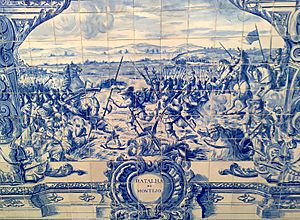Battle of Montijo facts for kids
Quick facts for kids Battle of Montijo |
|||||||
|---|---|---|---|---|---|---|---|
| Part of the Portuguese Restoration War | |||||||
 The Battle of Montijo (Military Museum of Lisbon) |
|||||||
|
|||||||
| Belligerents | |||||||
| Commanders and leaders | |||||||
| Matias de Albuquerque | Baron of Mollingen Marquis of Torrecusa |
||||||
| Strength | |||||||
| 6,000 infantry and 1,100 cavalry (6 guns) | 4,000 infantry and 1,700 cavalry (2 guns) | ||||||
| Casualties and losses | |||||||
| 3,000 dead and wounded (disputed) or about 900 dead and captured |
3,000 dead and wounded (disputed) or 433 dead 380 wounded |
||||||
The Battle of Montijo happened on May 26, 1644, near Montijo, Spain. It was a fight between the armies of Portugal and Spain during the Portuguese Restoration War. Both sides claimed they won, making the battle's outcome unclear. The fight was quite messy, so the exact number of soldiers who were hurt or died is different in various reports.
Contents
Why the Battle Happened
The Portuguese General Matias de Albuquerque wanted to show his military skills. He knew the Spanish army was led by the Marquis of Torrecusa, a very famous military leader.
Albuquerque gathered a large force. He had 6,000 foot soldiers (infantry), 1,100 horse soldiers (cavalry), and 6 cannons. He crossed the border into Spain. His troops attacked and burned some towns like Vilar del Rey and Puebla. They then reached the town of Montijo, which gave up without a fight.
The Battle Begins
General Albuquerque did not find the main Spanish army. So, he decided to march his troops back to Alentejo, Portugal. While they were marching, a Spanish force appeared. This force was part of Torrecusa's army. It was led by the Baron of Mollingen.
Mollingen's army had 4,000 foot soldiers and 1,700 horse soldiers. On May 26, 1644, the two armies met near Montijo.
Mollingen's Spanish forces formed a half-circle shape. This allowed them to attack the Portuguese army from the front and both sides at the same time. Albuquerque's army was marching slowly towards Portugal. He prepared for an attack from behind. He placed his foot soldiers in two defensive lines. The strongest groups were at the back. The supply wagons were at the front. His horse soldiers were split between the two sides of his army.
A Chaotic Fight
The Portuguese army fired their six cannons first. The Spanish cannons fired back, but they were not very effective. The Spanish horse soldiers then attacked the Portuguese left side. About 150 Dutch horse soldiers, led by Captain Piper, ran away in a panic. This panic spread to the rest of the horse soldiers on both sides of the Portuguese army. They left the battlefield and hid in nearby woods. This left the Portuguese foot soldiers without protection.
Mollingen himself led the Spanish horse soldiers. They easily broke through the middle of the Portuguese lines. They even captured the Portuguese cannons. Mollingen's troops thought they had won the battle. They spread out across the field and started looting.
Albuquerque's horse was killed, and he was fighting on foot. A French officer named Lamorlé, who was fighting for Portugal, gave Albuquerque his own horse.
Portuguese Comeback
The Spanish troops were spread out and had no backup forces. General Albuquerque and his officers saw this chance. They quickly gathered some of their scattered troops. They then managed to take back the Portuguese cannons.
D. João da Costa, a Portuguese artillery officer, used the cannons very well. He stopped the Spanish forces from regrouping. The rallied Portuguese troops fought back and pushed the Spanish across the Guadiana River. The Spanish suffered heavy losses.
What Happened After
The next day, the Portuguese troops returned to Campo Maior. Both sides said they had won the battle. They also claimed to have caused many casualties to the other side.
When King John IV of Portugal heard about Albuquerque's victory, he gave the general the title of Count of Alegrete. Both Madrid (in Spain) and Lisbon (in Portugal) celebrated the news of the battle. The battle was talked about a lot in the royal courts across Europe.
In Culture
The Battle of Montijo was important enough to be written about. Spanish writers Pedro Francisco Lamini and Sr. Durán wrote about it. A Portuguese writer named João Soares da Gama also wrote about the battle in his work Batalha do Montijo.
See also
 In Spanish: Batalla de Montijo para niños
In Spanish: Batalla de Montijo para niños

